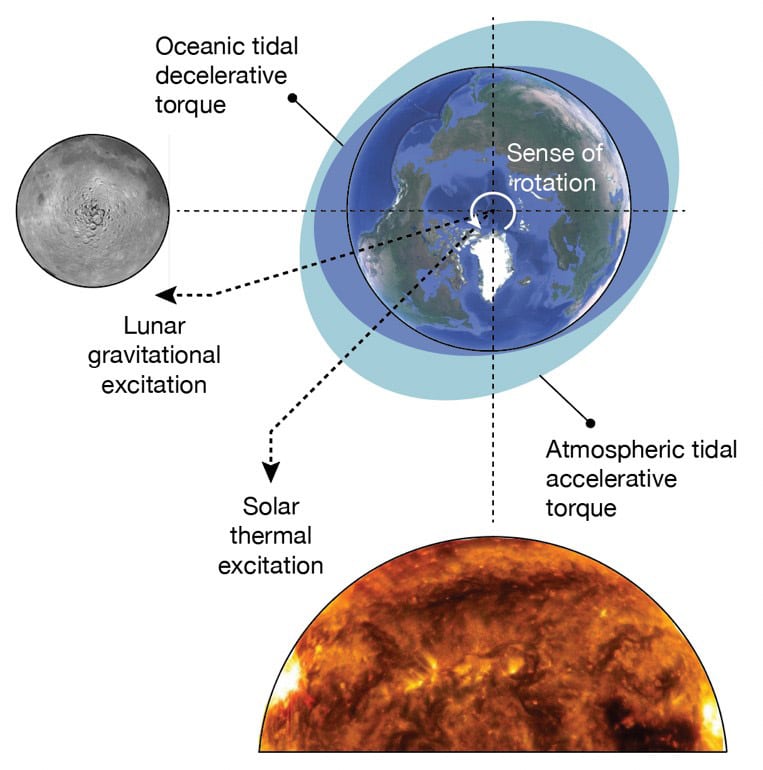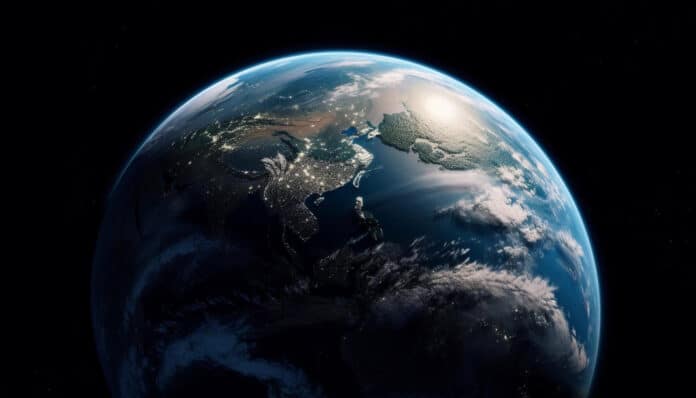Tidal forces of an orbiting satellite control the evolution of a planet’s rotation. Because Earth rotates faster than the orbital angular velocity of the Moon, Earth’s oceanic tidal bulge is pushed ahead of the Moon.
Earth rotates once in about 24 hours with respect to the Sun. It has been suggested that Earth’s rotation is slowing slightly with time. Now, a new study presents a statistical analysis of a compilation of observational constraints on the Precambrian length of day. It found that the day length on Earth used to last only 19 hours in the past.
Ross Mitchell, a geophysicist at the Institute of Geology and Geophysics of the Chinese Academy of Sciences, said, “Day length was shorter because the Moon was closer. Over time, the Moon has stolen Earth’s rotational energy to boost it into a higher orbit farther from Earth.”
How do researchers gauge ancient days? Geologists previously relied on data from unique sedimentary rocks that preserved extremely fine-scale layering in tidal mud flats. The number of hours in an ancient day can be calculated by counting the sedimentary layers produced by tidal changes each month.

But such tide records are uncommon, and those preserved are frequently contested. Fortunately, there is another way to determine how long a day is.
To identify astronomical “Milankovitch” cycles, which show how variations in the Earth’s orbit and rotation affect climate, cyclostratigraphy is a geologic technique.
Uwe Kirscher, co-author of the study and a research fellow now at Curtin University in Australia, said, “Two Milankovitch cycles, precession and obliquity, are related to the wobble and tilt of Earth’s rotation axis in space. The faster rotation of early Earth can therefore be detected in the past’s shorter precession and obliquity cycles.”
Scientists used a recent proliferation of Milankovitch records, with over half of the data for ancient times generated in the past seven years.
Mitchell said, “We realized it was finally time to test a kind of fringe, but a completely reasonable, alternative idea about Earth’s paleo rotation.”
The possibility that day length on Earth may have stagnated at a fixed value in the past is one untested notion. Earth also experiences solar tides caused by the atmosphere heating up during the day and ocean tides caused by the Moon’s gravitational attraction.
The strength of solar atmospheric tides is not as great as that of lunar oceanic tides, but this was not always the case. The tug of the Moon would have been much weaker in the past when Earth was rotating more quickly. The tide of the Sun pulls Earth as opposed to the Moon’s pull. As a result, the Sun accelerates Earth’s rotation while the Moon slows it down.
Kirscher said, “If in the past these two opposite forces were to have become equal, such a tidal resonance would have caused Earth’s day length to stop changing and to have remained constant for some time.”
Mitchell said, “Earth’s day length appears to have stopped its long-term increase and flatlined at about 19 hours roughly between two to one billion years ago—”the billion years,” commonly referred to as the ‘boring’ billion.”
The new research thus supports the hypothesis that longer days were required for photosynthetic bacteria to produce more oxygen each day before Earth’s climb to contemporary oxygen levels.
Journal Reference:
- Mitchell, R.N., Kirscher, U. Mid-Proterozoic day length stalled by tidal resonance. Nature Geoscience. (2023). DOI: 10.1038/s41561-023-01202-6
